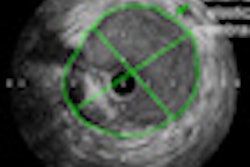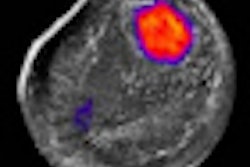Wednesday, December 1 | 11:20 a.m.-11:30 a.m. | SSK01-06 | Room E450A
Combining sonoelastography with conventional B-mode ultrasound improves the differentiation of benign and malignant breast masses smaller than 1 cm, according to this presentation by Korean researchers.The group wanted to see if adding sonoelastography to B-mode ultrasound could improve differentiation of small masses, with the ultimate goal of reducing unnecessary biopsies. To this end, they examined 315 breast masses (267 benign and 48 malignant) in a population of 278 patients who had been scheduled for biopsy between March and October 2009.
The performances of sonoelastography and B-mode ultrasound were analyzed independently and then in combination with each other. With elastography, radiologists calculated a strain ratio, thus producing elasticity scores.
Elasticity scores for malignant masses were 3.02 ± 1.33, significantly higher than those of benign masses (1.72 ± 0.78). Combining B-mode ultrasound with elasticity scores produced a sensitivity of 93.8%, specificity of 51.7%, positive predictive value of 25.9%, and negative predictive value of 97.9%.
The authors concluded that combining B-mode ultrasound with elasticity could reduce unnecessary biopsies of small suspicious breast masses, according to Sung Hun Kim, MD, who participated in the study.



















